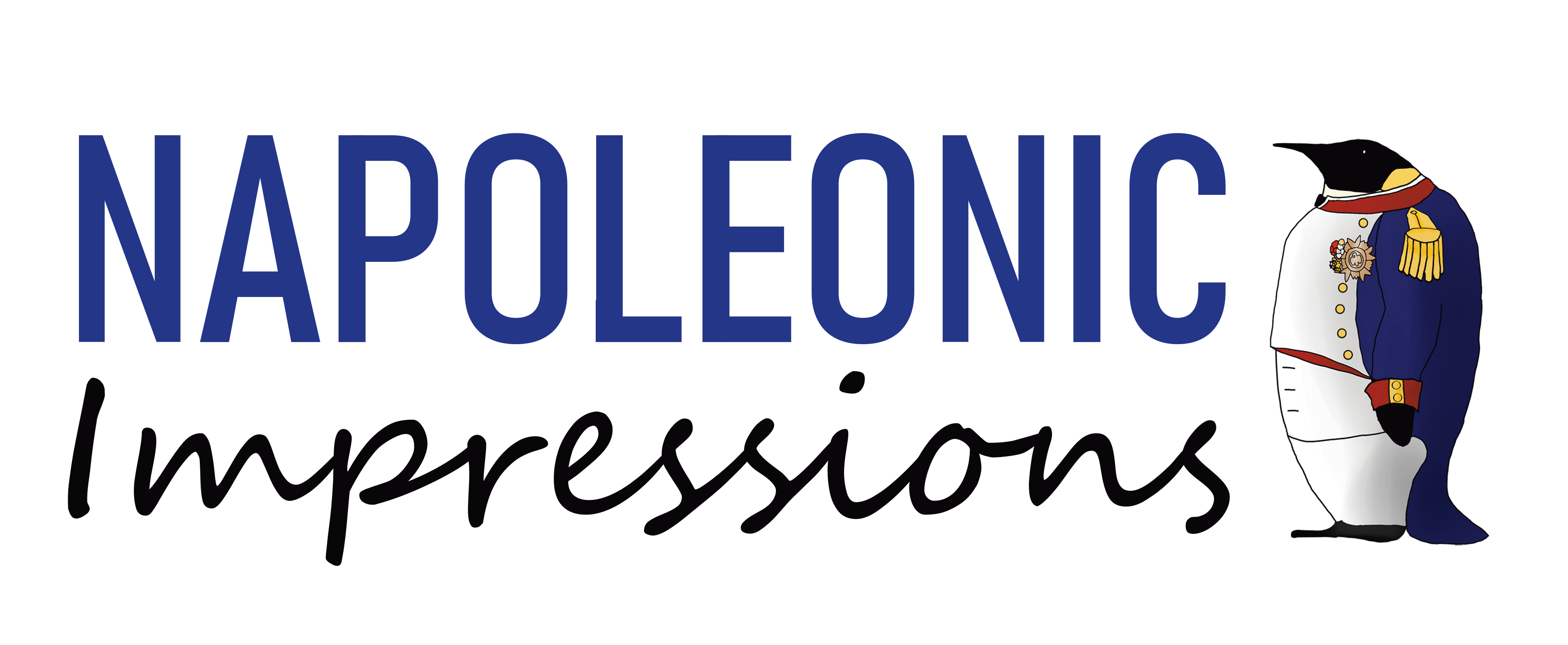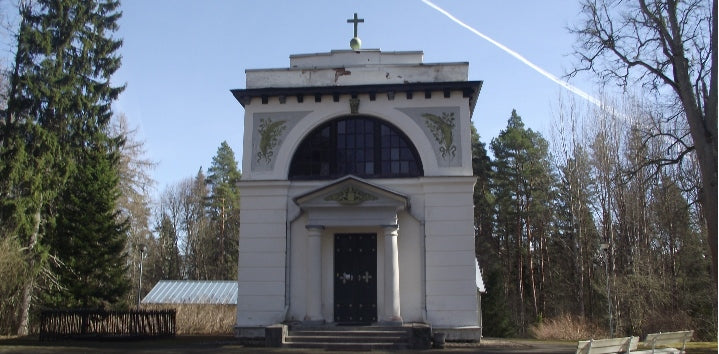This post about my visit(s) to the Barclay de Tolly Mausoleum is based on an article I first wrote in 2017, hoping it would be published on a travel blog. There were no takers, and it has been languishing in my files ever since. It sees the light of day for the first time here on the 202nd anniversary of Barclay de Tolly's death.
If you would like to read more about Barclay de Tolly, check out our article about him in our Ten Greatest Generals of the Napoleonic Wars series.
Once again I find myself in the middle of nowhere in southern Estonia on a cold April morning, this time behind the wheel rather than in the passenger seat. The SatNav on my phone counts down the distance to my destination. With a few hundred yards to go I make a turn and drive down the final stretch, trying not to floor the gas pedal in my excitement. Through the trees I catch a momentary glimpse of the small white building that was the object of my journey. This time I would surely get a look inside.
I drove up to the empty car park and walked up the path lined with trees on both sides, resembling a regiment of soldiers forming a guard of honour for their commander. This certainly proved to be a fitting resting place for a highly decorated general. I ran up to the entrance of the mausoleum. The gate was bolted shut. I walked round the back to the guard house – since converted into a small museum – it was equally quiet. Painful memories from two years ago flooded back into my mind. I checked the opening times on my phone. Why wasn't it open?
For most other people in the planet, or people whom I like to call normal human beings, what I had just experienced would not be considered a soul-destroying setback. For me, it was as though I had travelled the length of the country in order to watch a sporting match or a highly-anticipated concert – only to be stuck in traffic and arrive when it was already over. At this point the reader might find it useful to have some context about the whole situation.
***
Ever since I read Dominic Lieven's Russia Against Napoleon, I became obsessed with the Napoleonic invasion of Russia in 1812, and especially the life and career of Mikhail Barclay de Tolly. A Baltic German general with Scottish ancestry, Barclay de Tolly was Russian Minister of War from 1810 to 1812 and commanded the Russian army during the initial stages of Napoleon's invasion. Barclay was the architect of the defensive scorched earth strategy which eventually humiliated Napoleon's previously invincible army. But Barclay's strategic retreat was at odds with the offensive mentality of the Russian army, brought up on the glorious victories of Alexander Suvorov, whose shock-and-awe tactics carried battlefield after battlefield on the point of the bayonet. Censured by society as a German traitor, Barclay was superseded in command by Mikhail Kutuzov, who would go on to receive the spoils of victory.
Barclay's reputation was partially restored in 1813, once St Petersburg society began to appreciate his efforts in preserving the Russian army so that it could face Napoleon on terms of numerical parity. As Napoleon retreated from Moscow, Kutuzov's army continued the pursuit into Prussia and central Europe. When Kutuzov died of illness in April 1813, Barclay returned to the field and took overall command in June. Together with Prussian and Austrian allies, the Russian army under Barclay's command defeated Napoleon at the four day Battle of Leipzig (16-19 October 1813) before entering Paris in triumph the following March. By this time Barclay had been promoted to Field Marshal and received the title of Count. In 1815 he became a Prince. The motto on his princely coat of arms read 'Loyalty and Patience,' the two attributes that had led him to his high office.
A trusted advisor to Tsar Alexander I, Barclay's health was fading as a result of the wounds he suffered during his military service and he sought permission to travel abroad to seek a cure. Alexander, keen to retain the services of a trusted advisor, refused several of Barclay's requests. In 1818 permission was finally given and Barclay began his travels in the spring. It was too late. In the Prussian town of Insterburg (now Chernyakhovsk, Kaliningrad Oblast, Russia) Barclay died at the age of 56. His body was embalmed and returned to Russia. Tsar Alexander hoped to bury him in Kazan Cathedral in St Petersburg alongside the national hero Kutuzov, but Barclay's widow Auguste Eleanora objected. In 1823 a neoclassical mausoleum was built by the architect Apollon Shchedrin on the grounds of Barclay's estate at Beckhof (Jõgeveste, Estonia) where Barclay's body lies to this day.
When I had the opportunity to visit Ukraine and Poland in 2015 as part of a trip organised by the LSE Grimshaw International Relations Club, I decided to spend a week travelling through the Baltic states on my own at the end of the trip. On the whole I stuck to the capital cities of Vilnius, Riga, and Tallinn respectively, but I took the opportunity to make a detour to visit the Barclay de Tolly Mausoleum. The nearest city of any significance to the mausoleum is Valga, a border town divided between Estonia and Latvia some 30km away. I stayed at a hostel overnight with the intention of visiting the mausoleum the following day, Friday 3 April.
Not being a particularly religious person, until the previous evening I was completely unaware that 3 April was in fact Good Friday. All of Valga's tourist attractions – not that there were many – were closed. This was not a good sign. Although by now convinced that the mausoleum was going to be closed, I made my way to the bus station intending to catch a bus which never materialised. A taxi was parked in front of the bus station. The driver spoke no English but I was able to speak to him in Russian. As he drove me to the mausoleum, he told me that in his childhood – perhaps in the '60s or '70s – he had visited the mausoleum. Back then, he claimed, the sarcophagus was open, the embalmed body of the great general dressed in his uniform covered with his decorations. Later on – sometime in the '80s or '90s – the sarcophagus was closed. This was a great surprise to me – I had never come across any historical evidence for this, and certainly none of the history books mention it.
When we arrived at the mausoleum, I got out of the car and walked down the path, taking photos and the occasional selfie as I was going along. I encountered a couple walking the other way and asked in Russian if it was open.
"Closed. It's open tomorrow," they replied in English.
This was no good for me. I was off to Tallinn in the evening and couldn't change my plans. I walked round the mausoleum a couple of times, took some photos, and promised to myself that I would be back.
***
Two years later, I fulfilled my promise. I had just been on a research trip in Russia inspecting primary sources for my master's dissertation on music as an expression of Russian patriotism during the Napoleonic Wars, and decided to make a detour through the Baltics on my return journey. I spent the previous night in Tartu and hired a car in the morning. And once again the mausoleum was closed. Last time I could understand it. But this was within the advertised opening times on every website I looked at. There was no suggestion that anyone needed to call in advance to have it opened.
Normally in such circumstances – in Eastern Europe this happens fairly regularly – I would drive away, visit the next destination on my list and not worry about it. This was different. I had already made the trip in vain once before and was keen not to repeat the experience. I considered my options. There was no number to call, and in any case I couldn't figure how to turn on roaming on my phone. I opted to drive to the nearest town, Tõrva, which would probably have some sort of tourist information centre where I could at least ask someone why the mausoleum was not open.
The tourist information desk Tõrva was inside the bus station. For some reason – perhaps because it was the weekend – the desk was empty. In fact, there didn't seem to be anyone working at the bus station in any official capacity, even the ticket office seemed to be closed. Among the shops occupying the small building only one was open, a shop selling flowers and home furnishings. I approached the shopkeeper and told her of my woes, more in an effort to receive some sympathy than to find a solution to my problem. Fortunately, the woman happened to know someone who worked at the local tourist board and offered to call him on my behalf.
"How many people in your group?" she asked me as she was on the call.
"It's just me," I replied. My heart sank, thinking that there was no way anyone would go to the trouble of opening the mausoleum for a single visitor. After a short while the call ended.
"Please wait five minutes. He'll call me back."
I spent the ensuing five minutes browsing through the shop. I came across a small ceramic candle holder in the shape of an owl and thought it would be a nice gift for my girlfriend who, among other things, is obsessed with owls. The shopkeeper's phone rang and I rushed back to the till with the owl in hand.
"Someone who lives nearby will go and open the mausoleum at 1pm."
I looked at my phone. It was 12:45 and the mausoleum was a 10 minute drive away. I thanked the shopkeeper, bought the owl, told the shopkeeper to keep the change, and made my way back to the mausoleum.
By the time I was back at the mausoleum there was still no sign of any activity. It was not yet 1pm, so I stood by the entrance and waited. A couple of minutes later a woman approached riding a bike (since the location is so remote, I have no idea where she came from) and greeted me.
"Have you come to open the mausoleum?" I asked.
"Ah, so you are the person who called? Please, follow me."
She led me first into the guard house where there is a small display about Barclay's life and career. She explained that the house was built the same time as the mausoleum and was home to the same family for four generations. The display is simple, with the walls covered with information boards in four different languages: Estonian, Russian, English, and German. The Estonian and Russian content was usually much more detailed than the English and German. Although I knew all this information and much more, I still read the information carefully and took photos of every panel. In the centre of the room there are a couple of display cases, including a map of Europe which highlighted the places associated with Barclay's life and military career.
Once I had seen everything inside the guard house she unlocked the mausoleum itself. I stepped inside and was faced with the black granite funereal monument designed by the sculptor Vasily Demut-Malinovsky, familiar to me through photographs on the Internet. The centrepiece of the ensemble is a shoulder-length bust of Barclay with the inscription 'To Prince Barclay de Tolly, 1823.' A collection of military regalia, including a cuirassier's helmet and a crown, lies at the base of the bust. Barclay is flanked by two female figures. On the right, a Greek goddess (presumably Athena or Nike) crowns Barclay with a laurel wreath symbolising victory. On the left hand side a seated female figure leans on a cuirass and a shield, representing grief. The pedestal on which these sculptures stand is decorated with a frieze depicting the battle outside Paris in 1814. Barclay is seen in the centre of scene. To his right is his adjutant Baron Korf, whose family also hailed from what is now southern Estonia. At the very top of the monument there are seven stars arranged in a ring, somewhat resembling the flag of the European Union. These stars represent Barclay's greatest victories.
The wooden sarcophagi of Barclay and his wife lie in a vault beneath the mausoleum building. Stairs lead down to the vault, but the space is not accessible to visitors. Barclay's body lies in a brown coffin to the left, his wife in a black coffin to the right. My guide confirmed to me the story I had heard from the taxi driver two years earlier that Barclay's embalmed body was on display for several decades. Furthermore, in 2001 a group of experts came to examine the condition of the monument, both the building and the bodies buried within. They drew the conclusion that the great general's body is still in good condition two hundred years after his death, though they did not recommend that it be on display. Although a sense of morbid curiosity makes me wish that the photos could be made available – it is probably for the best that the coffin remains closed. As my guide remarked, 'It is better to look at the portraits and statues.'
Although I had seen all there was to see inside the mausoleum, my guide and I continued to talk for almost an hour about a range of topics – including details of my MPhil research, the location of Barclay's manor house (which was destroyed in the Second World War), members of Barclay's extended family around the world today (his only son, Magnus, died childless in 1872 and his princely title passed onto the descendants of his sister), as well as plans for the building's preservation. The inspection at the beginning of the century concluded that the materials used when the mausoleum was first built were adequate. However, a restoration job during the Soviet era had used substandard materials and as a result water has been seeping into the structure and is threatening its integrity. Restoration work is required – preferably within the next five years – but it is unclear how the funds will be raised, and with tense political relations between Estonia and Russia, it is also uncertain whether the Estonian authorities would be keen to prioritise the restoration of a Russian general's mausoleum – even if the Russian people have only embraced Barclay's legacy relatively recently.
When I first made my visit to the mausoleum two years earlier, I was reminded of C.V. Cavafy's poem Ithaca, which I was first introduced to during an Ancient Greek class at school. The poem was inspired by Odysseus's homeland of Ithaca, and claimed that the experiences acquired during the journey is more important than the destination itself. (I am not quite sure Odysseus himself would have agreed.) The conversation I had with the taxi driver was all the consolation I could take from that day. But I am not one to leave my journeys unfinished. On my second odyssey to visit the final resting place of one of my historical heroes, I was glad to discover that the destination was just as worthwhile.
If you enjoyed reading this blog post, please check out our Barclay de Tolly designs, including the following T-shirt:
Barclay de Tolly Matryoshka Unisex T-Shirt






Share and get 15% off!
Simply share this product on one of the following social networks and you will unlock 15% off!